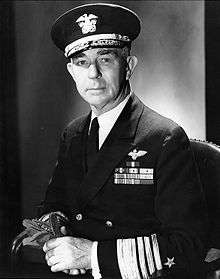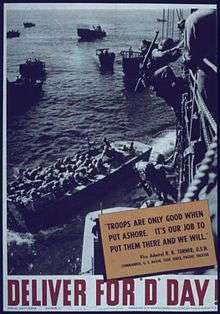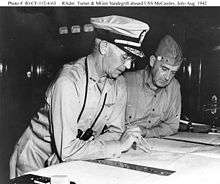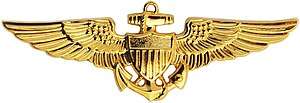Richmond K. Turner
Admiral Richmond Kelly Turner (May 27, 1885 – February 12, 1961), commonly known as Admiral Kelly Turner, served in the United States Navy during World War II, and is best known for commanding the Amphibious Force during the campaign across the Pacific.
Richmond K. Turner | |
|---|---|
 | |
| Birth name | Richmond Kelly Turner |
| Nickname(s) | Fighting Admiral |
| Born | May 27, 1885 Portland, Oregon |
| Died | February 12, 1961 (aged 75) Monterey, California |
| Buried | |
| Allegiance | |
| Service/ | |
| Years of service | 1904–1947 |
| Rank | |
| Commands held | USS Mervine (DD-322) USS Jason (AC-12) Commander Aircraft Squadrons, Asiatic Fleet USS Saratoga (CV-3) USS Astoria (CA-34) Director of the War Plans Division Assistant Chief of Staff to the Commander in Chief Commander, Fifth Amphibious Force Commander Amphibious Forces, U.S. Pacific Fleet (ComPhibPac) |
| Battles/wars | World War II
|
| Awards | Navy Cross Navy Distinguished Service Medal (4) Army Distinguished Service Medal |
Early life and career
Richmond Turner was born in Portland, Oregon on May 27, 1885, to Enoch and Laura Francis (née Kelly) Turner. His father alternated between being a rancher and farmer, and working as a printer in both Portland (for The Oregonian with his older brother Thomas) and Stockton, California (where he owned a small print shop). Young Richmond would spend most of his childhood in and around Stockton, with a brief stop in Santa Ana, and graduated from Stockton High School in 1904.[1]
He was appointed to the U.S. Naval Academy from California's sixth district, his name put forward by Congressman James C. Needham, in 1904. He graduated on June 5, 1908 and served in several ships over the next four years.
On August 3, 1910, he married Harriet "Hattie" Sterling in Stockton.[2]
In 1913, Lieutenant (Junior Grade) Turner briefly held command of the destroyer USS Stewart. After receiving instruction in ordnance engineering and service on board the gunboat Marietta, he was assigned to the battleships Pennsylvania, Michigan and Mississippi during 1916–19. From 1919 to 1922, Lieutenant Commander Turner was an ordnance officer at the Naval Gun Factory in Washington, D.C. He then was gunnery officer of the battleship California, fleet gunnery officer on the Staff of Commander Scouting Fleet and commanding officer of the destroyer Mervine.
Following promotion to the rank of commander in 1925, Turner served with the Bureau of Ordnance at the Navy Department. In 1927, he received flight training at Pensacola, Florida, was designated as a naval aviator, and a year later became commanding officer of the seaplane tender Jason and commander, Aircraft Squadrons, Asiatic Fleet. He had further aviation-related assignments into the 1930s and was executive officer of the aircraft carrier Saratoga in 1933–34. Captain Turner attended the Naval War College and served on that institution's staff in 1935–38 as head of the Strategy faculty.
Turner's last single ship command was the heavy cruiser Astoria, on a diplomatic mission to Japan in 1939. During his service with that vessel, Astoria, the body of deceased Japanese Ambassador to the United States, Hiroshi Saito was returned to Japan. Saito died of tuberculosis in February 1939. Following the World War II, Turner received Order of the Sacred Treasure, 3rd Class by the Emperor of Japan.[3]
Turner was Director of War Plans in Washington, D.C., in 1940–41 and was promoted to rear admiral January 1941.[2]
Responsibility for Pearl Harbor
As Director of War Plans in Naval Operations, Captain Turner became the Naval Member of the Joint Planning Committee of the Joint Board. Turner and Colonel Joseph T. McNarney, Air Corps, US Army wrote "Study of the Immediate Problems concerning Involvement in War" in late December 1940. This led to Plan D, a strong offensive war in the Atlantic and a defensive war in the Pacific. This evolved into US war plan "Rainbow Five".[2]
On 25 November 1941, Turner drafted a despatch to the Commander in Chief of the Asiatic Fleet for release by the Chief of Naval Operations (CNO), which contained the words: "I consider it probable that this next Japanese aggression may cause an outbreak of hostilities between the U.S. and Japan." CNO Admiral Harold Rainsford Stark took this message to the President—who changed the releasor to himself—and softened the judgment words "probable" to "possible" and "may" to "might," and he added the bad guess: "Advance against Thailand seems the most probable."
The Commander of the U.S. Pacific Fleet, Admiral Husband E. Kimmel, was highly aware of the threat of surprise Japanese attack at Pearl Harbor. The final and most important warning was sent from Washington and to other Pacific outposts on 27 November 1941. It was specifically designated as a "war warning."[4]
Turner made the decision not to send Kimmel details of the intercepted Japanese diplomatic communications which pointed strongly to an imminent air or sea attack on the Pacific Fleet's base at Pearl Harbor. Kimmel testified after the war that had he known of these communications, he would have maintained a much higher level of alert and that the fleet would not have been taken by surprise by the Japanese attack. A historian of the attack on Pearl Harbor, Professor Gordon Prange, wrote in Pearl Harbor: The Verdict of History that, even allowing for Kimmel's desire to exculpate himself, this was correct. Prange wrote: "If Turner thought a Japanese raid on Hawaii... to be a 50-percent chance, it was his clear duty to say so plainly in his directive to Kimmel... He won the battle for dominance of War Plans over Intelligence, and had to abide by the consequences. If his estimates had enabled the U.S. to fend off... the Japanese threat at Pearl Harbor, Turner would deserve the appreciation of a grateful nation. By the same token, he could not justly avoid his share of the blame for failure."[5]
Vice Admiral Homer N. Wallin wrote a much more comprehensive analysis of the reasons for the U.S. defeat at Pearl Harbor.[6][7] See also Rear Admiral Edwin T. Layton, Kimmel's chief intelligence officer, and his book, And I Was There.[8]
Admiral Turner testified to the Roberts Commission on 19 January 1942, the Admiral Thomas C. Hart Inquiry on the 3rd and 4 April 1944, the Navy Court of Inquiry headed by Admiral Orin G. Murfin on 15 September 1944 and the Joint Congressional Committee Investigating Pearl Harbor in 1946.[9]
World War II


In December 1941, Turner was appointed assistant chief of staff to the Commander in Chief, United States Fleet (a new position created after Pearl Harbor for Admiral Ernest King), serving until June 1942. He was then sent to the Pacific to take command of the Amphibious Force, South Pacific Force. Over the next three years, he held a variety of senior Amphibious Force commands as a rear admiral and vice admiral. He helped plan and execute amphibious operations against enemy positions in the south, central and western Pacific. He would have commanded the amphibious component of the invasion of Japan.
For the Guadalcanal Campaign, Rear Admiral Turner was Commander, Amphibious Force South Pacific, also known as Task Force 62 which included 9 Groups, including Landing Force, Major-General Alexander Vandegrift and Screening Group, Rear Admiral Victor Crutchley, Royal Navy. He successfully fought the five-month campaign to victory which included the galling defeat at Savo Island when Admiral Frank Jack Fletcher withdrew his aircraft carriers, exposing the landing force to a Japanese night attack.[10]
For the assault on the Russell Islands, Rear Admiral Turner, COMPHIBSOPAC, was named as the Commander of the Joint Force designated Task Force 61, with the Commanding General 43rd Infantry Division, Major General John H. Hester, U.S. Army, being the Commander Landing Force. For the assault on the New Georgia Groups of Islands, Rear Admiral Turner, COMPHIBSOPAC, was named as the Commander Task Force 31 which included New Georgia Occupation Force, Maj. Gen. Hester.[11]
For the assault on Tarawa and Makin, Rear Admiral Turner was named as the Commander, Assault Force Task Force 51, which included 10 Groups, including Northern Attack Force for Makin and Southern Attack Force for Tarawa, Rear Admiral Harry W. Hill.[12]
At Tarawa: "Rear Admiral Turner, the Task Force Commander and Immediate Senior in Command, was well over the horizon and busy with the problems of Makin. Vice Admiral Spruance, the Commander Central Pacific Force, was present at Tarawa in the Indianapolis, but with that quality which endeared him to all his subordinates, did not undertake to kibitz on the minute-by-minute performance of the local Task Force or Task Group Commanders. To Rear Admiral Harry Hill belongs full credit for a great and hard-fought victory at Tarawa."[13]
For the assault on the Marshall Islands, Roi-Namur and Kwajalein, Rear Admiral Turner was the Commander, Joint Expeditionary Force, Task Force 51, which included 3 Task Forces and 9 Task Groups.[14]
As a result of his leadership in these many amphibious assaults, Turner was promoted to Vice Admiral on March 7, 1944.[15]
For the assaults on Tinian, Guam and Saipan, Vice Admiral Turner was the Commander, Joint Expeditionary Force, Task Force 51, which included the Northern and Southern Task Forces, Expeditionary Task Force, Lt Gen Holland Smith and 6 Task Groups.[16]
For the assault on Iwo Jima, Vice Admiral Turner was the Commander, Joint Expeditionary Force, Task Force 50, which included the Attack Force, Rear Admiral Hill, and Expeditionary Task Force, Lt. Gen Smith.[17]
At the Battle of Okinawa Turner commanded Task Force 51 which included the Northern Attack Force, Rear Admiral Lawrence Fairfax Reifsnider, the Southern Attack Force, Rear Admiral Hill, Expeditionary Troops, Lt. Gen. Simon Bolivar Buckner Jr., Western Island Attack Group, Rear Admiral Ingolf N. Kiland, Amphibious Support Force Rear Admiral William H. P. Blandy and Gunfire and Covering Force, Rear Admiral Morton Deyo. At the end of the Battle of Okinawa the Amphibious Forces under Admiral Turner's command were manned by 657,000 officers and men.[18]
On May 24, 1945 Richmond Kelly Turner was promoted to full Admiral.[19]
He would have commanded the amphibious component of the invasion of Japan. Amphibiously, under Admiral Turner's command, there were to be 2,700 ships and craft in the Kyushu operation. There had been 1,213 ships and craft under his command for the Okinawa operation, 435 for the Marianas operation and 51 at Guadalcanal.[20]
Postwar
After World War II, Admiral Turner served on the Navy Department's General Board and was U.S. Naval Representative on the United Nations Military Staff Committee. He retired from active duty in July 1947. Admiral Turner died in Monterey, California, on February 12, 1961. He is buried in Golden Gate National Cemetery in San Bruno, California, alongside his wife and Admirals Chester Nimitz, Raymond A. Spruance, and Charles A. Lockwood, an arrangement made by all of them while living.
Personality
Admiral Turner was known in his surrounding by his complicated personality and furious temper. Nicknamed "Terrible Turner", many of his subordinates and colleagues recognized his command abilities, but criticized his manners, heavy drinking and pedantry on the other hand.
When Admiral Chester Nimitz accepted Turner as commander of his assault force, Nimitz dryly said of the assignment that:
Turner was "brilliant, caustic, arrogant, and tactless — just the man for the job".[21][22]
Future Marine General, Robert E. Hogaboom, who served as his Assistant Chief of Staff for Operations describes him as:
The greatness of Admiral Kelly Turner was in that Kelly Turner worked his plans out in minute detail himself, right down to the last position of every amphibious vessel; where they would be, when they should be there, what they were to do. I knew him personally and I know that he was a fighting man. He was tough...he was not always fair, but he insisted on his people doing what they were supposed to do.[21][23]
General Nathan Twining, who served as Chief of staff of the Allied air forces in South Pacific during World War II, described Turner as:
A loud, strident, arrogant person who enjoyed settling all matters by simply raising his voice and roaring like a bull captain in the old navy.... [His] peers understood this and valued him for what he was, a good and determined leader with a fine mind — when he chose to use it.[24]
Honors and depictions
The Leahy-class destroyer leader (later classified guided missile cruiser) USS Richmond K. Turner (DLG-20/CG-20) was named in honor of Admiral Turner.
Turner appears in To the Shores of Iwo Jima, a documentary short film depicting the American assault on the Japanese-held island of Iwo Jima and the massive battle that raged on that key island in the Allied advance on Japan.[25]
Turner was portrayed by actor Stuart Randall in the film The Gallant Hours.
Decorations
Here is the ribbon bar of Admiral Richmond K. Turner:
 | |||
| Naval Aviator Badge | |||||||||||||
| 1st Row | Navy Cross | Navy Distinguished Service Medal with three Gold Stars | Army Distinguished Service Medal | ||||||||||
|---|---|---|---|---|---|---|---|---|---|---|---|---|---|
| 2nd Row | Navy Unit Commendation | World War I Victory Medal with "ATLANTIC FLEET" clasp | American Defense Service Medal with "FLEET" clasp | ||||||||||
| 3rd Row | American Campaign Medal | Asiatic Pacific Campaign Medal with two silver 3/16 inch service stars | World War II Victory Medal | ||||||||||
| 4th Row | Philippine Liberation Medal | Companion of the Order of the Bath (United Kingdom) | Order of the Sacred Treasure, 3rd Class (Japan) | ||||||||||
See also
- Guadalcanal Campaign, first major amphibious operation
References

- "Admiral Richmond K. Turner, USN (1885–1961)". Online Library of Selected Images: People — United States. Naval Historical Center, Department of the Navy. Retrieved February 1, 2009.
- Dyer, George Carroll, Vice Admiral USN (Ret) (1969). The Amphibians Came to Conquer: The Story of Admiral Richmond Kelly Turner. Introduction by Rear Admiral Ernest M. Eller, USN (Ret). Washington, D.C.: United States Government Printing Office. LCCN 71603853.CS1 maint: multiple names: authors list (link)
- Wallin, Homer N., Vice Admiral USN (Ret) (1968). Introduction by Rear Admiral Ernest M. Eller, USN (Ret). "Pearl Harbor:Why, How, Fleet Salvage and Final Appraisal". Naval Engineers Journal. Washington, D.C.: United States Government Printing Office. 80 (6): 897–900. doi:10.1111/j.1559-3584.1968.tb04583.x. ISSN 1559-3584. Retrieved May 28, 2017.CS1 maint: multiple names: authors list (link)
Footnotes
- Dyer, George Carroll (1972). The Amphibians Came to Conquer. Washington, D.C.: U.S. Dept. of the Navy; U.S. Government Printing Office. pp. 3–9. OCLC 476880.
- Dyer. - p. 154
- Calloway, James R. (1958). Congressional Record: Proceedings and Debates of the 88th Congress (PDF). Washington, D.C.: United States Government Printing Office. pp. A182. Retrieved April 9, 2017.
- Dyer, George Carroll (1972). The Amphibians Came to Conquer. Washington, D.C.: U.S. Dept. of the Navy; U.S. Government Printing Office. p. 177. OCLC 476880.
- Gordon W. Prange, Donald M. Goldstein and Katherine V. Dillon, Pearl Harbor: The Verdict of History, McGraw-Hill, 1986, 292-295
- Wallin, Homer N. "Pearl Harbor: Why, How, Fleet Salvage and Final Appraisal". Hyperwar. Retrieved May 28, 2017.
- Wallin, Homer N. (1968). Pearl Harbor: Why, How, and Fleet Salvage, and Final Appraisal. Naval History Division. pp. 41–56. ASIN B001VT7GVU.
- Layton, Edwin T. (1985). And I Was There: Pearl Harbor and Midway Breaking the Secrets. with Roger Pineau & John Costello. William Morrow & Co. ISBN 0688048838.
- Dyer, George Carroll (May 28, 2017). "The Amphibians Came to Conquer: THE STORY OF ADMIRAL RICHMOND KELLY TURNER". Hyperwar, page 1117.
- Dyer, George Carroll (May 28, 2017). "The Amphibians Came to Conquer THE STORY OF ADMIRAL RICHMOND KELLY TURNER". Hyperwar, page 281.
- Dyer, George Carroll (May 28, 2017). "The Amphibians Came to Conquer: THE STORY OF ADMIRAL RICHMOND KELLY TURNER". Hyperwar, page 460.
- Dyer, George Carroll (May 28, 2017). "The Amphibians Came to Conquer: THE STORY OF ADMIRAL RICHMOND KELLY TURNER". Hyperwar, page 524.
- Dyer, George Carroll (May 28, 2017). "The Amphibians Came to Conquer: THE STORY OF ADMIRAL RICHMOND KELLY TURNER". Hyperwar, Page 631.
- Dyer, George Carroll (May 28, 2017). "The Amphibians Came to Conquer: THE STORY OF ADMIRAL RICHMOND KELLY TURNER". Hyperwar, page 754.
- Dyer, George Carroll (May 28, 2017). "The Amphibians Came to Conquer: THE STORY OF ADMIRAL RICHMOND KELLY TURNER". Hyperwar, page 848.
- Dyer, George Carroll (May 28, 2017). "The Amphibians Came to Conquer: THE STORY OF ADMIRAL RICHMOND KELLY TURNER". Hyperwar, page 875.
- Dyer, George Carroll (May 28, 2017). "The Amphibians Came to Conquer: THE STORY OF ADMIRAL RICHMOND KELLY TURNER". Hyperwar, page 997.
- Dyer, George Carroll (May 28, 2017). "The Amphibians Came to Conquer: THE STORY OF ADMIRAL RICHMOND KELLY TURNER". Hyperwar, page 1072 and 1105.
- Dyer, George Carroll (May 28, 2017). "The Amphibians Came to Conquer: THE STORY OF ADMIRAL RICHMOND KELLY TURNER". Hyperwar, page 1107.
- Dyer, George Carroll (May 28, 2017). "The Amphibians Came to Conquer: THE STORY OF ADMIRAL RICHMOND KELLY TURNER". Hyperwar, page 1108.
- "Fortitudine Volume 19, Part 2" (PDF). marines.mil. Marine Corps Websites. Retrieved January 25, 2015.
- America's Fighting Admirals. William Tuohy - America's Fighting Admirals. Zenith Press. Retrieved February 1, 2007.
Americans Fighting Admirals: Winning the War at Sea in World War II.
- "Gen Hogaboom Dies; WWII Vet Was HQ Chief of Staff - Fortitudine No 23, Part 2" (PDF). marines.mil. Marines Websites. Retrieved February 10, 2018.
- Black Shoe Carrier Admiral: Frank Jack Fletcher at Coral Sea, Midway, and Guadalcanal by John B. Lundstrom. Black Shoe Carrier Admiral. Naval Institute Press. March 11, 2013. ISBN 9781612512204. Retrieved February 1, 2006.
- U.S. Government Office of War Information (June 15, 2017). "IMDB To The Shore of Iwo Jima". IMDB.
- "Author Dies". Daily Herald. newspapers.com. August 1, 1948. Retrieved March 25, 2019.(subscription required)
Further reading
- Hoyt, Edwin Palmer (1970). How They Won the War in the Pacific: Nimitz and His Admirals. Weybright and Talley. ASIN B0006C5D54.